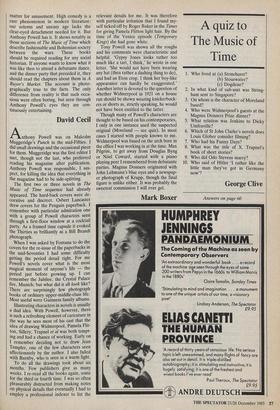A nthony Powell was on Malcolm Muggeridge's Punch in the mid-Fifties.
I did small drawings and the occasional piece for them. Muggeridge was the first editor I met, though not the last, who preferred reading his magazine after publication. Anthony Powell was responsible, I sus- pect, for killing the idea that everything in the magazine had to be side-splitting.
The first two or three novels in The Music of Time sequence had already appeared. The hard-back covers were de- corative and discreet. Osbert Lancaster drew covers for the Penguin paperback. I remember with particular admiration one with a group of Powell characters seen through a first-floor window at a cocktail party. As a framed time capsule it evoked the Thirties as brilliantly as a Bill Brandt photograph.
When I was asked by Fontana to do the covers for the re-issue of the paperbacks in the mid-Seventies I had some difficulty getting the period detail right. For me Powell's novels cover what is the most magical moment of anyone's life — the period just before growing up. I can remember the Jubilee, the Crystal Palace fire, Munich; but what did it all look like? There are surprisingly few photograph books of ordinary upper-middle-class life. Most useful were Guinness family albums.
Illustrating characters in novels is usually a dud idea. With Powell, however, there is such a refreshing element of caricature in the way he sees most of his cast that the Idea of drawing Widmerpool, Pamela Flit- ton, Sillery, Trapnel et al was both tempt- ing and had a chance of working. Early on I remember deciding not to draw Jean Templer, one of the few characters seen affectionately by the author. I also failed with Barnby, who is seen in a warm light.
To do all the drawings took about six months. Few publishers give as many weeks. I re-read all the books again, some for the third or fourth time. I was so often pleasurably distracted from making notes on physical details that eventually I had to employ a professional indexer to list the
relevant details for me. It was therefore with particular irritation that I found my- self ticked off by Roger Baker in the Times for giving Pamela Flitton light hair. By the time of the Venice episode (Temporary Kings) she had gone white.
Tony Powell was shown all the roughs and his comments were characteristic and helpful. 'Gypsy Jones looks rather too much like a tart, I think,' he wrote in one letter. 'She would not have been wearing any hat (then rather a dashing thing to do), and had an Eton crop. I think her boy-like appearance can hardly be exaggerated.' Another letter is devoted to the question of whether Widmerpool in 1921 on a house run should be shown wearing knickerbock- ers or shorts as, strictly speaking, he would not have been entitled to the latter.
Though many of Powell's characters are thought to be based on his contemporaries, I only in one instance used the suspected original (Moreland — see quiz). In most cases I started with people known to me. Widmerpool was based on the arch bore in the office I was working in at the time. Max Pilgrim, to get away from Douglas Byng or Noel Coward, started with a piano playing peer I remembered from debutante parties. Magnus Donners originated with John Lehmann's blue eyes and a newspap- er photograph of Krupp, though the final figure is unlike either. It was probably the sweetest commission I will ever get.
Mark Boxer


















































































 Previous page
Previous page